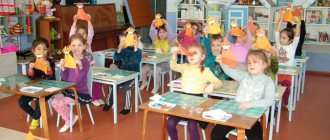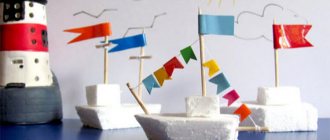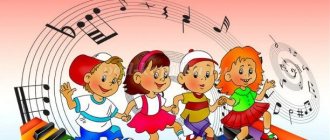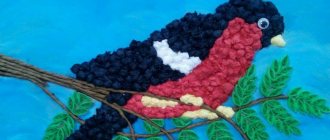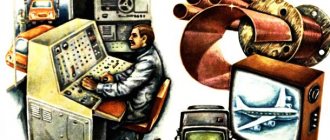Progress of the lesson:
And from hunger - bark. ( Hare )
- Today we will make a hare. Winter has come and snow has fallen. Guys, what color will we make the hare? (White)
— Why is the hare white in winter ? (This is camouflage. On white snow, a white hare is hardly noticeable .)
1. Take a white thin sheet and fold it in half. On one half we measure three narrow strips 1.5 cm wide, and leave the other half whole . Cut along the lines. Cut out two short strips of pink paper blanks for the ears .
2. half of a white sheet in half and cut into two wide strips .
3. Bend strip We got two wide strips of different lengths .
two cylinders from wide , and from the cut off part we make a ring - this is the tail.
5. Glue two large cylinders into the number 8.
6. Take narrow strips : glue droplets from two narrow strips , and cut the third strip in half .
7. Glue rings from two short strips and glue pink ears onto white droplets - “ears”
.
8. Glue the ears, paws, and tail to the hare. Eyes, mustache, nose can be drawn.
9. The hare is ready ! You can finish the front legs.
Christmas balls made of stripes. Master class You can make a huge number of different crafts from paper strips. I bring to your attention a New Year's resolution: Making a ball. Children's - master class "Flower Glade" on 3D applique from paper strips of colored paper Good day, dear friends and colleagues. I bring to your attention a children's master class on making compositions using. Children's master class on making crafts from paper rolls “Hare” Children of any age love to be creative. And you can make your own crafts not only from materials purchased in the store. Master class “The Scarlet Flower”. Volumetric applique from paper strips of colored paper Master class: Volumetric applique from paper strips of colored paper “Scarlet Flower” Author: Yulia Vladimirovna Fedoseeva Age:. Master class “Toys from paper strips” for children of primary school age Goal: to make toys from paper strips. Objectives: Educational -Introduce the technology of making toys from stripes -Teach how to mark. Master class "Crab". Construction from paper strips for the lexical topic “Sea inhabitants” Today we will go to the seabed to visit a crab that prefers to hide from people. This amazing creature is. Master class on applique “Hedgehog” from paper strips for children 5–6 years old Theme of the application: “Hedgehog”. Master class for children of senior preschool age. Application is modeling on a plane. Application.
Hare made of paper strips: stages of creation
Cut 8 strips of paper 1 cm wide. 4 long and 4 slightly shorter so that the head is smaller than the body. This is done at your own discretion, depending on how tall the bunny is needed.
The strips will stick together exactly in the center, so determine the middle in advance by simply bending the strip in half.
A fold is formed, this is where you glue the strips on top of each other.
First, create a kind of snowflake from long strips, gluing the middle.
Then start connecting the opposite ends, securing them with glue in the same place, until you get a ball.
Try to make the sides equal, without tightening the stripes, otherwise the hare will turn out crooked.
Repeat the whole process with short strips and make a smaller ball.
Glue them together.
Cut out ears from blue and pink paper. And also the nose, teeth, if there are no ready-made moving eyes, then make them out of paper.
Glue it to the hare's head. To glue the ears, bend their tips slightly.
The work is completed, this is how the cute hare turned out from strips of paper. If the work interests you, you can make a bright garland from paper strips, which will decorate any festive event. And also a fun Easter chick.
Bunny made of paper circles: three-dimensional paper bunny step by step
Volumetric bunny made of paper circles. Step-by-step review for children with photos. A simple paper hare for children's creativity.
For work you will need the following materials:
- Blue paper and cardboard;
- White paper;
- Plastic moving eyes;
- Black felt-tip pen, compass, scissors, glue.
Summary of the lesson on designing “Circus animals from cylinders”
Maria Smirnova
Summary of the lesson on designing “Circus animals from cylinders” • Continue introducing children to the technique of paper sculpture.
planar and volumetric curvilinear (
cylindrical ) in one design .
• Introduce children to the method of twisting a rectangle into a cylinder .
• Formation in children of the ability to analyze samples of structures , highlighting a familiar method of design , and independently use the mastered methods to create new, more complex structures .
Preliminary work: looking at illustrations, postcards with pictures of animals , reading poems and stories about animals and the circus .
Material: the hall is decorated with balloons, music.
The teacher creates an object-based play environment on the screen: flat figures of a gnome, a house, a pond, a clearing, an oak tree, a fir tree, a forest, mushrooms, and pets . Figures of circus animals , made on the basis of a cylinder : a frog, a bear, a hare. The following material is prepared for each child: a rectangular sheet of paper of different colors (7cm*14cm, 2 rectangular strips (11cm*3cm, animal , glue, pencil, scissors, glue brush, stand for brushes, napkins, oilcloth. Magician's costume (cape, hat, chest and “magic”
stick. For the teacher: a rectangular sheet of paper, a paper
cylinder , strips of paper, scissors.
Bunny made of paper circles step by step
Making the torso
For the body, cut out 6 blue and 2 white circles. Of course, colors and their combinations can be absolutely any. If the bunny is dedicated to Easter, then it can be of all pastel colors, even pink.
Fold the circles in half. The straighter you fold it, the more correct and stable your torso will be.
Glue the circles into one whole, fastening along one side.
You will get this ball-body of a hare.
Cut out a long figure eight from cardboard. These will be the bunny’s paws, and also a support, thanks to which the craft will take a stable vertical state and will not fall to one side.
Glue the paws on the bottom. It is safer to use PVA glue.
bunny head
The head in this craft is flat, in contrast to the voluminous body. Cut out for her:
- Circle made of blue cardboard;
- Blue ears and white additions to them;
- White teeth.
You can also prepare the paws at this stage.
Glue ears, eyes, nose, teeth, draw a muzzle. The head is ready.
Attach it to the body, placing it between the glued parts. For stability, apply a little glue first. If the head does not fit into the desired area, cut there with scissors. Alternatively, you can make an accordion neck and glue the head to it. Also glue on the sides of the paws.
Source
What will you need to create a bunny?
- Blue and pink pastel colored cardboard;
- White cardboard for teeth;
- Moving eyes or just a little white and black paper for eyes;
- A simple pencil, scissors, a glue stick, a black felt-tip pen.
If you use paper in your work, the bunny will turn out to be unstable, but you can hang it on a ribbon or make a garland. If you need the hare to be durable, to decorate a table and other surfaces in a vertical state, you should work with cardboard, but not very hard.
Easy option
Simply roll a couple of balls of different sizes to get the body and head of a bunny.
It is necessary to show this to the child so that he understands the essence of the process.
Then four small cylinders are rolled out to serve as the feet. After this, the nose and ears are done.
The whole thing is secured with black dots that will serve as eyes, and the craft is ready. However, this is not enough.
To make a greater impression, you need to create an environment for it, besides, the small size allows you to include more details that will not require much effort and time. This way you can make a small house nearby, or a whole family of hares.
Beautiful paper bunny
Things are completely different if you need a medium-sized craft. Plasticine in such quantities is very heavy and quite expensive, so you need to use other materials. And the best material in this matter is paper or cardboard. From these 2 components you can make virtually anything. The main thing is to draw the scans correctly, or find ready-made ones on the Internet and print them out.
You should take into account the fact that just a hare will look quite ordinary against the background of other crafts, it will not stand out. Therefore, it is necessary to include something special in the design.
In order to glue a hare out of paper, in the easiest way, you only need to twist a cylinder, and then stick on it a pair of beautifully cut and painted eyes, and then ears with paws. And that’s it, the easy craft is ready. You can add some small detail, in the form of a carrot. However, to make the craft more detailed and beautiful, you will need to try.
Preview:
Summary of GCD for paper construction in the senior group on the topic “Hare”.
- consolidate the skills of folding a sheet of paper in different directions, ironing the folds;
- cultivate perseverance and careful attitude to the material;
- develop fine motor skills and attentiveness.
Material: illustrations with the image of a hare; paper squares (10x10); colour pencils.
Educator: - Guys, today a letter arrived in our group, but the envelope doesn’t say who it’s from, but there’s a riddle. Try to guess it:
Educator: - Guys, who are we talking about in the riddle? (Children's answers).
Educator: - That's right about the hare. What do you know about the hare? (Children's answers).
- Do you want to know what the hare wrote to you?
The teacher reads the letter: “Hello, dear children. My name is Tim the hare, I want to tell you about myself. I live in the forest, in the fields. I'm an excellent runner, I run very fast. When I feel danger, I immediately run away. It’s dangerous for a hare to run through the forest during the day—I’m sitting in a hole. And in the evening I come out of my hiding place to eat and run around to my heart’s content. I am a herbivore. In summer I eat grass, in winter I eat tree bark, thin branches of aspen and birch, various berries, and seeds. In winter, I change my gray coat to white so that predators do not notice me. Well, that's all guys. Don't forget to take care of nature and animals. Hare Tim."
Educator: - Guys, what do you remember from Tim’s letter? (Children's answers).
Educator: -Guys, let's make Tim friends? What do you think we will make from? (From paper). Right.
Educator: - Take a square, fold it diagonally, bend it again.
We bend two corners up exactly in the middle so that the ears stick out.
The bunny is ready, then we draw the eyes, nose, and mustache.
Educator: -Well done guys, look how many friends we have made for Tim! (exhibition of works).
Educator: - Guys, who were we talking about? (Children's answers). What did Tim the hare say in the letter? (Children's answers).
Educator: - Who did we do in class? How? (Children's answers). That's right, guys. Well done!
Three-dimensional figurine
At the very beginning, you need to carefully cut out the scans from the paper. After that, fold them sequentially, glue them with glue, and leave to dry.
While the main part of the figure is drying, you can proceed to the remaining parts. Next, the bunny’s paws and ears are cut out and glued together. By that time, the main part of the figure will already be dry, and the remaining parts can be glued onto it.
Origami hare for children
Using this diagram you can make a paper hare for children with your own hands. The model will surely appeal to children, because these playful origami hares , if controlled correctly, can move: they can curtsy, straighten their backs, tilt their heads and much more.
To make such a cute little animal, you only need a square sheet of paper. How to make an origami hare is shown in the diagram.
If this scheme is too complicated for you, detailed step-by-step instructions can be found on the website, the link is below.
Photo source: luntiks.com/kids-origami/how-to-make-origami-for-kids-step-by-step-paper-moving-hare-1772.html
How to make a soft toy with your own hands
To embroider a bunny, you will need a fairly wide range of materials and work tools:
- scissors;
- textile;
- foam;
- chalk;
- sewing machine (if not, you can sew by hand);
- glue;
- various materials for decoration (to choose from).
First, a pattern for the toy is drawn up; you can make it yourself, or simply download it from the Internet. After which it is printed and projected onto the fabric.
It is applied to the fabric using chalk, since it is clearly visible on it and can be erased if unnecessary strokes are made.
Once the pattern is ready, you can cut it out of the fabric. Then, stitching of certain sides begins, usually those that are at the back. The rest remain open. This is done so that the figure can be filled with foam rubber or cotton wool to give it volume.
After all sides are sewn, use scissors to trim off any uneven edges and threads. Then the stage of decorating the toy begins. This is a great way to hide all the seams that are present on it. They can be covered with various details, similar to the type of clothes for a bunny. At the same stage, eyes, ears and paws with a tail are sewn on. At the final stage, it is necessary to inspect the resulting toy for any mistakes made in order to correct them.
You can make a bunny in completely different ways. However, it is important to understand that the child must do more than half the work. This will allow him to study, acquire important and necessary skills that will be useful to him later in life. In addition, joint activities bring parents and children closer together, and generally change their relationship for the better.
Source
